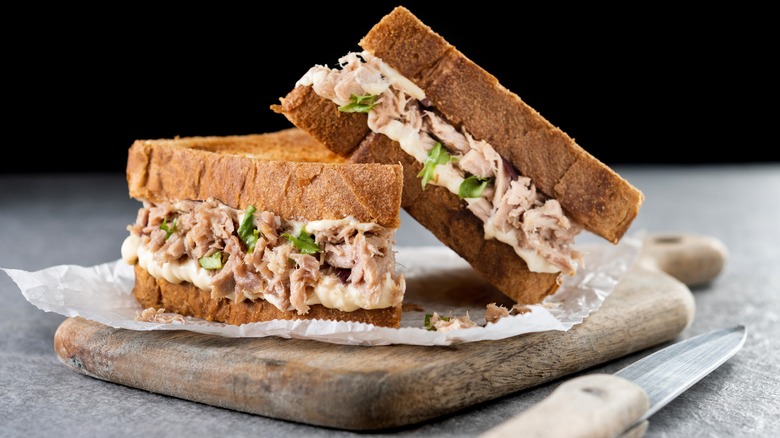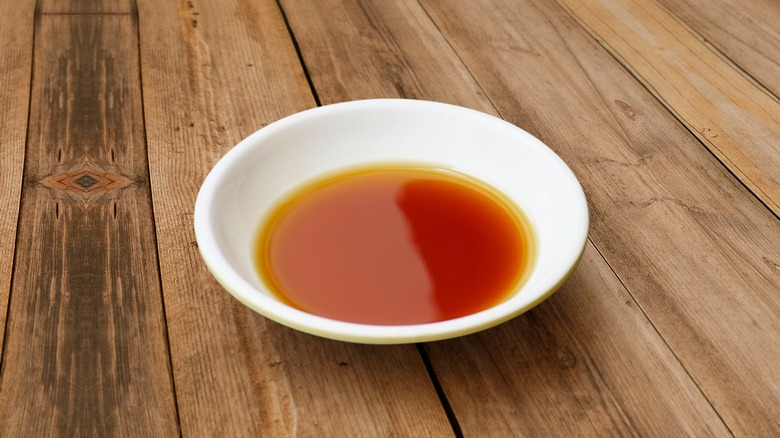Make Your Tuna Sandwiches Unforgettable With One Extra Ingredient
The classic tuna salad sandwich became a popular American lunch during the early twentieth century, and the canned fish dish has stuck around even if it's not considered a fancy lunch. There's a lot going on with both texture — the tuna is firm, the mayo is creamy, the chopped onions and celery add a crunch — and with taste. Tuna tastes less "fishy" than salmon or other popular fishes because it's got lots of the protein myoglobin, which gives it both its redder color (myoglobin is also in red meat) and a more savory, beefy taste.
Using fish sauce to add more fishy flavor to the sandwich isn't a bad idea, though. Fish sauce has a distinctly umami taste to it that's noticeable without being overpowering. When done right, it can blend into the other ingredients without completely changing the sandwich, all while leaving behind some extra zest that is noticeable. It's a great way to round out the meaty canned tuna and the tangy mayonnaise, making the whole mix more flavorful.
The fishy taste of fish sauce
Fish sauce is a popular ingredient in Southeast Asian cooking. It's made from fermenting small fish like anchovies or shrimp and then salting the mixture, and cooking with fish sauce brings out a distinctly umami flavor. It's similar to Worcestershire sauce or soy sauce, but it's more mellow (it's more pungent when raw).
You've almost certainly tasted umami before, but it can be difficult to describe. It's often seen as being somewhere between "salty" and "savory," without quite fitting into either category. Anything umami gets its flavoring from an amino acid called glutamate — as opposed to sour flavors which come from acids, sweet flavors which come from sugars, and salty flavors from salt. Umami pops up in lots of meats and fish, as well as certain cheeses and mushrooms.
You only need to add a little fish sauce to make a difference in a tuna sandwich. Mixing ½ teaspoon into the mayo, lemon juice, or other dressings can be enough. Add too much and you'll risk bringing that umami flavor out of the background and into the foreground, which isn't necessarily bad, but it's different.
Umami alternatives for your tuna
There are other ways to bring in that umami zest to tuna salads and sandwiches. Worcestershire sauce is an easy substitute, and you can find plenty of recipes that include a dash of it. Keep in mind that it's got a stronger flavor thanks to its numerous other ingredients, particularly the vinegar base, so it may not disappear into the background. Soy sauce is similar: A strong umami taste, but other fairly distinctive sweet, salty, and even bitter notes.
If you want to stick with seafood to make your tuna feel more at home, oyster sauce is made from caramelized oyster juices and boasts a similar umami profile. It tends to be thick and syrupy thanks to the cornstarch in it, though. Or, going back to the main ingredient of fish sauce, you might consider adding minced anchovies directly into the tuna. The French tuna sandwich (pan bagnat) is made this way, by using lots of anchovy filets and olives to make the tuna extra salty. Making it French-style makes the sandwich extra soggy because there's olive oil involved — soggy tuna beats dry tuna, but if you're just after that umami kick, the anchovies are enough.


